10 Web Design Principles That Will Boost Your Conversion Rate
6 mins | 14 May 2022

Table of content
2. impressive statistics based on web design
Introduction
The design of your website is exclusively responsible for the success of a sales funnel and the traffic of your website. Your web design can make a lot of difference in increasing the conversion rate for you. There's a significant impact on the perception of your brand and sales credibility.
For internet users, it doesn't take much time to develop a perception of your business just by browsing through your website. To keep your audience engaged with your products & services, your website design should be attractive as well as pristine. Moreover, it's not simply about aesthetics; your website must be designed in such a way that it encourages your audiences to take action.
The design of your website directly influences a lot of factors such as your clicks, user engagements, and conversions, all these fundamental metrics help to increase the effectiveness of your website and the revenue of your business.
Let's have a look at the impressive statistics based on web design :
- 48% of people believe that a brand is judged by its website design.
- A survey found that 53% of people opt out of a website if its page takes a longer time, i.e. more than 3 seconds.
- According to a study, 94% of negative website feedback was solely related to design.
- For a website user, it only takes about 0.05 seconds to create a viewpoint about your website.
- Online shoppers, about 88%, said that they would never return to a website after having a bad user experience.
- 57% of internet users said that they wouldn't suggest a business with a poorly designed website on mobile.
- 84.6% of web designers have chosen that crowded web design is the most common blunder made by small businesses.
In this article, we will talk about the principles of web design that will boost your conversion rate. By implementing these principles of web design, you can effectively turn the tables for yourself!
Read Also: Why web design is important in your business?
Top 10 Web Design Principles
1) Don't Forget To K.I.S.S. - Keep It Simple, Stupid!
This one is the most effective and popular web design principle. K.I.S.S, also known as Keep It Simple, Stupid is widely recognised as the most valuable principle of all. The phrase itself is easily understood, which says "Simplicity is the key to success". This principle explains to always aim for simplicity and to create easy actions for your audience so that there isn't any confusion.
Also, it's similar to Hick's law, the quality of being simple and uncomplicated in the form of design. A page overloaded with information gives rise to a complex situation and doesn't go well with internet users.
When you keep things straightforward, they become even more visually appealing. Building an excellent user experience also helps you in opting out of anything unnecessary to the web design.
2) Stick To Hick's Law
Hick’s Law, or the Hick-Hyman Law, is named after a British and an American psychologists team of William Edmund Hick and Ray Hyman. It's a popular theory that is quoted by many individuals for different objectives, but it is mostly referred to as web design.
Hick's law describes that a person who is loaded with a lot of choices will take a much longer time to conclude. In simple terms, when the number of choices given to a person increases, the time taken to make a decision also increases.
A popular theory in the field of web design explains why many brands are limiting the content on their navigation bar. This way, it becomes a lot easier for the users to find a definite solution for their specific problem.
3) Obey The 8 Second Rule
Have you heard yet that the human attention span is even less than 12 seconds? Yes, you read that right!
Nowadays, people typically lose their concentration power just after eight seconds. That's the reason why it's vital to make those 8 seconds count the moment they visit your website.
There are a lot of things you can do to seize their attention, such as the hero image on your website should be out of the ordinary & extremely attractive, teamed up with a headline that helps describe your products & services in terms of benefits offered to your target customers. You can even use "exit animated pop-ups" to once again engage the visitors who got bored after a certain period. Curate the sign-up/register buttons pretty large so that I will be easily visible to the audience and try to include multimedia content like video, audio or any content that is interactive.
4) Make Use Of High-Quality Images
One thing that could pull down the quality & integrity of your blog or any content on your website is because of low-quality images. Images are truly responsible for causing a positive or negative impact on the users & their actions. Articles with appropriate images receive more than 94% of views when compared to articles without any images. Moreover, 67% of customers confessed that the quality of a product image is “very essential” in choosing and buying the product.
You should try to avoid low-quality, lifeless images in your blog posts or web pages.
If you are wondering where to get free stock images, then click here!
5) Rule Of Third
You might be thinking that "The Rule of Third" is only limited to photography, but you must be inquisitive to know that it’s undoubtedly one of the fundamental principles of web design. Rule of thirds suggests visually intersecting a page of the website into thirds. Substantially, this will result in leaving you with two equally spaced vertical & horizontal lines, i.e. nine equal square boxes.
After this, you need to concentrate on the given four sections in the middle because, according to the Rule of Third, this space is the strategic space of attention. You must position the essential elements of the website here, such as features of your products, CTA or a highly influential image.
6) The Strength Of Colors
Colours are more than a mechanism to continue to stay as a manual of style, it makes your website look impressive. Apart from your website's aesthetics, there's much more to the colours. Colours play a vital role in expressing a message and give a soothing effect to one's mind. It does affect the perception of the people about your brand, whether it's online or offline.
Always remember that there are specific colour combinations that can give rise to various kinds of emotions, so it's essential for you to create a well-thought-out idea that is useful in expressing your brand's message neatly and without any confusion. If you come up with the right choice of colours, half of the things will be sorted out.
To choose the colours that best express your brand, you might need to collaborate with a design agency, 12grids is here to help you with that!
Read Also: How to choose the right colour scheme for your website?
7) Invest In Optimum Speed
The Internet is one of the reasons why people have become so impatient with time. You would be surprised to know that just a 2-second delay has been successful in contributing to a 103% increase in bounce rates.
Every second counts when it comes to page loading speed, ensuring that you design a website for your business for optimum speed. There are various ways through which you can achieve this criterion, such as performing a compression audit, minimizing HTTP requests, minifying and incorporating files and enabling browser caching. These are a few ways that will help you to increase the speed of your website.
About this particular web design principle, you should always try to check your website page's speed and whether there are any troubleshooting issues.
8) Utilize Faces To Stretch Familiarity
Humans do connect with other humans, and there's an exchange of positive energy between them. When you follow this principle and incorporate pictures of other people instead of using vector images, people will connect to that. Many studies describe how using images of people increases the conversion rate because users feel more comfortable & connected.
Nevertheless, always try to drive away from stock images because customers are more likely to trust businesses that are personal and genuine.
9) Gestalt Similarity Principle
Gestalt principles or laws are rules that narrate how the human eye observes visual components. These principles strive to exhibit how complicated events can be lessened to more simple patterns. They also aspire to illustrate how the eyes anticipate the shapes as a single, united form instead of having distinct, simple elements.
The initial Gestalt principle is the law of similarity that confesses that the human eye or brain prefers to group similar objects, and it's a means that enables us to create a sense of things and to regulate a noisy environment.
When it comes to web design principles, you can enforce this law by sorting items into groups that you want to be connected to, for instance - images, testimonial boxes, or conversion buttons.
10) Have Regard To F-Layout
According to various research that has been carried out in recent years, browsing a web page in an F-pattern is the innate behaviour of internet users. In simple words, people tend to look from the left side of the page to the right side, starting at the topmost part of the screen. As they scroll down the page, they just scrutinize the page.
This means that the part which receives less attention is the bottom-most part of the page. Hence, you should place the essential elements & messages considering the F-layout.
Conclusion
The 10 web design principles that are listed above are great for improving and enhancing the conversion rate of your website, but it’s also mandatory to understand that design prospers hand in hand with user experience. The key to ensuring conversion relies on your knowledge & understanding of how your market recognises & observes your brand and the information you express through your website.
If you continue to serve your market needs, everything else will fall into place!
Author

Share
Share
Related

Polymers, Innovation, And A Modern Website: The Goldstab Organics Journey
5 mins : 10 Nov 2025

From Friction to Finish Line: The God of Sports Digital Transformation
6 mins : 17 Sept 2025

The Future Of Responsive Web Design: Emerging Trends, Innovations And Predictions In 2024
7 mins : 26 Apr 2024
Other Articles

Responsive Web Design: Understanding The Basics For Seamless User Experiences
7 mins : 29 Apr 2024

Everything You Should Know About The Ideal Screen Size For Responsive Design
6 mins : 26 Apr 2024

Enhance Your Web Design Creativity with Google Web Designer
4 mins : 17 Nov 2023
